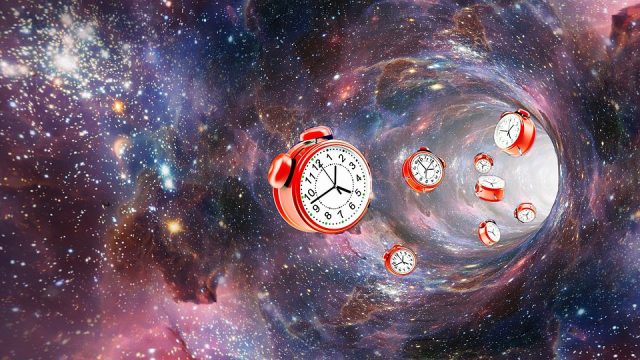The Road to Quantum Gravity (2): The emergence of Space and Time

The division of past and future
In Part 1 of this series, we presented the empirical fact that under extreme circumstances, a certain observer’s past can be in another observer’s future. To explain this, we introduced the network of cause and consequence relations as the fixed background structure of reality. This network constitutes Spacetime. Causality imprints a structure on it, which depends on the observer, thus explaining the initial disagreement. On this chapter we will explain how space and time, as seemingly separate entities, arise from this structure.
The way that Spacetime gets structured by causality divides it into 3 regions. Given a certain event (that is, a point in Spacetime), and following the logic of cause and consequence, we have:
-
The region from which causal influence is received. This constitutes the past.
-
The region to which causal influence can be exerted. This constitutes the future.
-
The region to which no causal influence can be exerted, and from which no causal influence can be received either. This region has no name, but it is important. We will get back to it below.
Different observers can be affected by, and can exert, different causal relations, and ultimately this is why their past and future do not agree. Notice that in the presented definitions, past and future are no longer defined by their position on a fixed timeline. We are prioritizing cause-consequence relations as the fixed, objective reality. Time is subjective because our causal relations with the rest of Spacetime are subjective to our own experience.
In a practical physical situation, observers are usually measurement instruments. They perceive and exert different causal relations due to their velocities, trajectories of rays of light and similar physical notions. But bringing it down to the basics, we can describe generically how space and time are identified within this new and refined logic.
Time is the easiest: your timeline follows the most obvious chain of cause-consequence relations: your existence at a certain event causes your existence at other events. This identifies a line through the event network, a path cut through Spacetime that physicists call worldline.
In this context, our psychological experience of the flow of time arises from the partial knowledge that we have about the rest of the Spacetime, including the knowledge of other events within our worldline in which we have an even more reduced knowledge. All of these other versions of yourself are just there, either in the past (exerting causal influence through memories) or in the future (receiving causal influence).
Given another observer moving at a constant velocity from you, their worldline appears as a sloped line compared to yours. The greater the velocity, the more sloped it gets, until reaching the limiting velocity given by the speed of light.
Space is a bit harder to describe. In a naive way, we could say that space is what we see around us. But since light travels at a finite speed, the further an object is from us, the longer its light has travelled. This argument is often brought up in the cosmological context: we do not see stars the way they are now, but the way they were years ago.
More precisely, the present image of the world around you is a collection of spherical shells, each one corresponding to events further and further into the past. Therefore, it is not a sensible way of defining space. In fact, in our construction this image constitutes the boundary between the past and the third region mentioned above.

In the example of a star, we can have knowledge of its History up until the information transmitted by the last ray of light that we are seeing now. And if we sent a signal now, it would take years to reach. Thus, there is a region of the star’s History that does not fall within our past nor our future.
A better way to define space is as the collection of simultaneous events. We say two events are simultaneous when they happen “at the same time”, but in a world where time is subjective, that sentence is badly defined. Instead, thinking pragmatically we can notice that in practice, what we would do is wait until the light of those events reaches us, and then build the set of spatial events retroactively by calculating the trajectories of those rays back to their source. In this way we infer simultaneity from the way light reaches us.
For an observer moving at a constant velocity towards the left, light from the left reaches sooner that light from the right, and so their set of simultaneous events at time t=0 is different from ours. They reach a different conclusion because they are referring to a different collection of events, thus making space a subjective concept as well.
Notice the important role that light plays in all of these arguments. Indeed, this is a physical problem, and thus physical concepts, such as light, are involved.
Shrunk space, dilated time
The way space and time change, or transform, as we change from one observer to another is called the Lorentz transformation. This concept was introduced by Poincaré 1 before Einstein’s theory of relativity was ever announced, as a way to provide a mathematical description of certain phenomena found in the physics of light by Lorentz 2. The specific mathematics of this transformation operation leave unchanged the spacetime interval quantity that we introduced in Part 1.
In practice, the transformation can be summarized in distances that expand or shrink, and time that compresses or dilates. If we travel at half the speed of light, distance changes dramatically from our point of view. An observer left behind would see us traveling the entire distance, but they would perceive our clocks as having slowed. The combination of length contraction and time dilation allows both observers to agree on how much older everyone looks at the end of the journey. These phenomena may sound outlandish, but they have been directly observed in laboratories.
The effects of relativity are usually stated as time flowing more quickly or more slowly. Even though that is an accurate description of how these effects are perceived, it does not give the right intuition about Spacetime relationships. The right intuition comes from looking at the fundamental concepts behind and talking about when causality reaches an observer, and about tracing trajectories of causality.
In the next entry of this series, we will explore the reason for this cosmic limit of light speed, and how that relates to our perception of time. For now, this is what the relativity of space and time is all about.
References
- H. Poincaré, “On the Dynamics of the Electron”, Comptes Rendus Hebdomadaires des Séances de l’Académie des Sciences, 140: 1504–1508 (1905) ↩
- H. Lorentz, “Electromagnetic phenomena in a system moving with any velocity smaller than that of light”, Proceedings of the Royal Netherlands Academy of Arts and Sciences, 6: 809–831 (1904) ↩
2 comments
[…] Aldibereko gertaeren sorta baino ez da espazioa. Eta gertaeren sarean lerro bat osatzen du denborak. Daniel Fernándezek hobeto azaltzen du The Road to Quantum Gravity (2): The emergence of Space and Time […]
Such addiction to the same too old shallow and narrow human point of view will not help Jan develop toward any discovery they
still have even yet been able to understand what I have briefly said about such unexplainable natural phenomena as what they call as “super positions” or quantum michenics which reject all their traditional knowledge of natural sciences which is obviously beyond their current limited knowledge , and they are just beginning to grope their way around to discover more about the impossible in their traditional limited knowledge
Again the human concepts of time, the past , the present and future , space dimension and dimension never exist in the infinite space of the universe
As long as human scientists are still unable to understand what they can see or observe without such human subjective concepts , they will not be able to understand super positions and why there is no such human wild imagination things as the expasion nor shrinkage of the infinite space , and the concept of the speed of light is only applicable able within what they can observe . In other words light speed is not a constant I’m different parts of the infinite space which human species’ will never be able to cover before their current form of existence or that of the Earth
expires